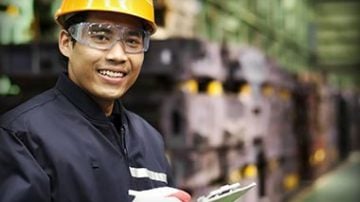At the core of every construction endeavor lies the challenge of hazard controls. Hazard controls are an indispensable factor in navigating risk mitigation, ensuring the well-being of our workers, and upholding the rigorous safety standards that govern Canadian industries.
Hazard control requires a multifaceted approach that encompasses preventative strategies, engineering controls, administrative measures, and the strategic utilization of Personal Protective Equipment (PPE).
Learn more about common hazards encountered daily by Canadian contractors, effective control methods, and how you can keep your job site in compliance with safety regulations.
Common Hazards in Canadian Construction
Falls, Electrical Hazards, Machinery-Related Risks, and Beyond
In Canadian construction, various hazards pose risks to the safety and well-being of workers. Here are some common hazards faced by Canadian construction workers:
- Falls: Working at heights is inherent in many construction projects, leading to the risk of falls. This includes falls from ladders, scaffolding, roofs, or other elevated surfaces.
- Electrical Hazards: Construction sites often involve the use of electrical tools and equipment, increasing the risk of shocks, electrocutions, and electrical fires.
- Hazardous Materials: The handling and use of hazardous materials, such as chemicals, asbestos, and lead, can pose serious health risks to construction workers if not managed properly.
- Machinery-Related Risks: Construction sites employ a variety of heavy machinery, including cranes, bulldozers, and excavators. Improper use or malfunction of these machines can lead to accidents and injuries.
- Struck-by and Caught-in/Between Hazards: Workers can be struck by moving vehicles, falling objects, or caught in/between machinery and structures, leading to severe injuries.
- Confined Spaces: Construction projects often involve work in confined spaces, which can pose risks such as poor air quality, limited access, and the potential for engulfment.
- Noise and Vibration: Construction sites generate high levels of noise, exposing workers to the risk of hearing damage. Vibrations from tools and machinery can also cause long-term health issues.
- Manual Handling and Ergonomics: Lifting heavy objects and poor ergonomic practices can lead to musculoskeletal disorders among construction workers.
- Fire and Explosions: Welding, cutting, and other hot work activities can lead to fires. Additionally, the presence of flammable materials increases the risk of explosions.
- Weather-Related Hazards: In Canada, extreme weather conditions, especially during winter, can pose additional challenges and risks to construction workers, including frostbite and slippery surfaces.
Effective Hazard Prevention Strategies
In Canadian construction sites, various methods of hazard control are employed to ensure the safety of workers. These methods can be broadly categorized into prevention strategies, engineering controls, administrative controls, and the use of personal protective equipment (PPE).
Proper Planning and Design
- Emphasize the importance of thorough planning and well-designed work processes to prevent hazards from occurring.
- Ensure that construction projects are organized in a way that minimizes risks and enhances safety.
Physical Changes to the Work Environment
- Implement engineering controls to physically modify the workplace and reduce or eliminate hazards.
- Examples include installing machine guards, creating proper ventilation systems, and incorporating ergonomic designs into workspaces.
Work Procedures and Safety Training
- Develop and enforce clear work procedures that outline safe practices for specific tasks.
- Prioritize comprehensive safety training programs to educate workers on potential hazards and safe work practices.
- Conduct regular safety meetings to reinforce training and address specific concerns on-site.
Personal Protective Equipment (PPE)
- PPE serves as a crucial last line of defense against certain hazards.
- Ensure that workers are provided with and wear the appropriate PPE for their specific tasks and the associated risks.
- Examples include hard hats, safety glasses, gloves, hearing protection, and respiratory protection.
Emergency Protocols
- Establish and communicate emergency response plans to address unforeseen situations.
- Conduct regular drills to ensure that all workers are familiar with emergency procedures and evacuation routes.
Adherence to Canadian Safety Regulations
- Ensure strict adherence to safety regulations outlined by Canadian authorities.
- Regularly update safety protocols to align with any changes in regulations or industry standards.
Communication and Reporting Systems
- Foster an open communication system where workers feel comfortable reporting hazards and safety concerns.
- Implement reporting mechanisms for near misses and incidents to identify areas for improvement.
Construction Hazard Safety Training for Canadian Job Sites
Construction Hazard Safety Training is not only a legal requirement but also a moral obligation to protect the well-being of workers. It plays a pivotal role in creating a safety-conscious culture within the construction industry, reducing accidents, and fostering a secure working environment. Training programs should be tailored to the specific needs of Canadian construction sites, considering the unique challenges posed by the country's geography, climate, and regulatory framework.
Employers investing in comprehensive safety training for their workers not only ensure compliance with regulations but also contribute to the overall success and reputation of their projects. Workers who are well-versed in hazard identification and control are better equipped to handle challenges, leading to increased productivity and, most importantly, the prevention of accidents and injuries on Canadian construction sites.
Industrial Compliance & Safety partners with contractors working on job sites in Canada to ensure up-to-date, robust safety training for their teams.
Compliance with Canadian Safety Regulations
In the ever-evolving landscape of workplace safety, compliance with Canadian safety regulations such as CCOHS, stands as a cornerstone for every responsible contractor. Hazard controls play a pivotal role in not just meeting but exceeding these regulations, ensuring a work environment that prioritizes the well-being of all individuals involved.
Key Aspects & Benefits of Regulatory Compliance
- Canadian safety regulations mandate that contractors adhere to stringent safety measures.
- Hazard controls are not merely recommendations; they form the backbone of legal obligations that contractors must fulfill to guarantee the safety of their workforce.
- Different industries face unique risks, and hazard controls are tailored to address these specific challenges.
- Hazard controls are not reactive measures but proactive strategies to prevent risks before they materialize.
- Canadian safety regulations are dynamic, requiring contractors to adapt to evolving standards.
- Hazard controls foster a culture where safety is ingrained in every aspect of operations.
- Contractors take responsibility for the safety of their workforce by not just meeting minimum standards but by actively seeking and implementing measures that elevate safety to a higher standard.
- Contractors investing in hazard controls invest in the long-term viability of their operations.
Choose Industrial Compliance & Safety for Regulatory Compliance
Industrial Compliance & Safety stands as your dedicated partner in achieving safety excellence that goes beyond regulatory compliance. Showcase your commitment to the welfare of your workforce by integrating robust hazard controls, surpassing regulatory expectations, and fostering a workplace culture where safety is not just a requirement but a shared value. Together, let's build a safer, more resilient future for Canadian industries. Connect with us at Industrial Compliance & Safety, where your journey toward safety excellence begins.
Ready To Get Compliant Today?
Call us or complete the form below!





